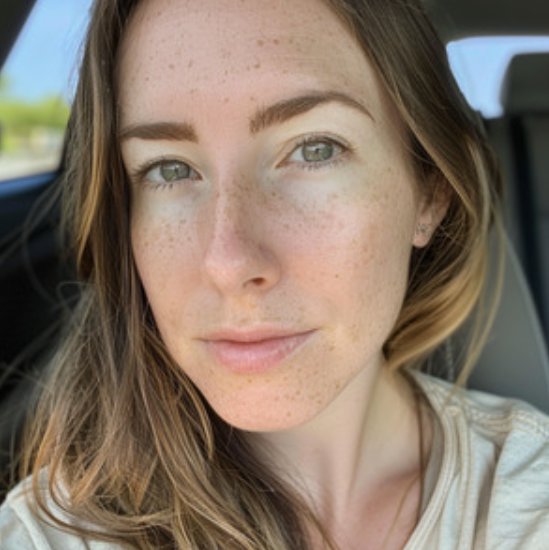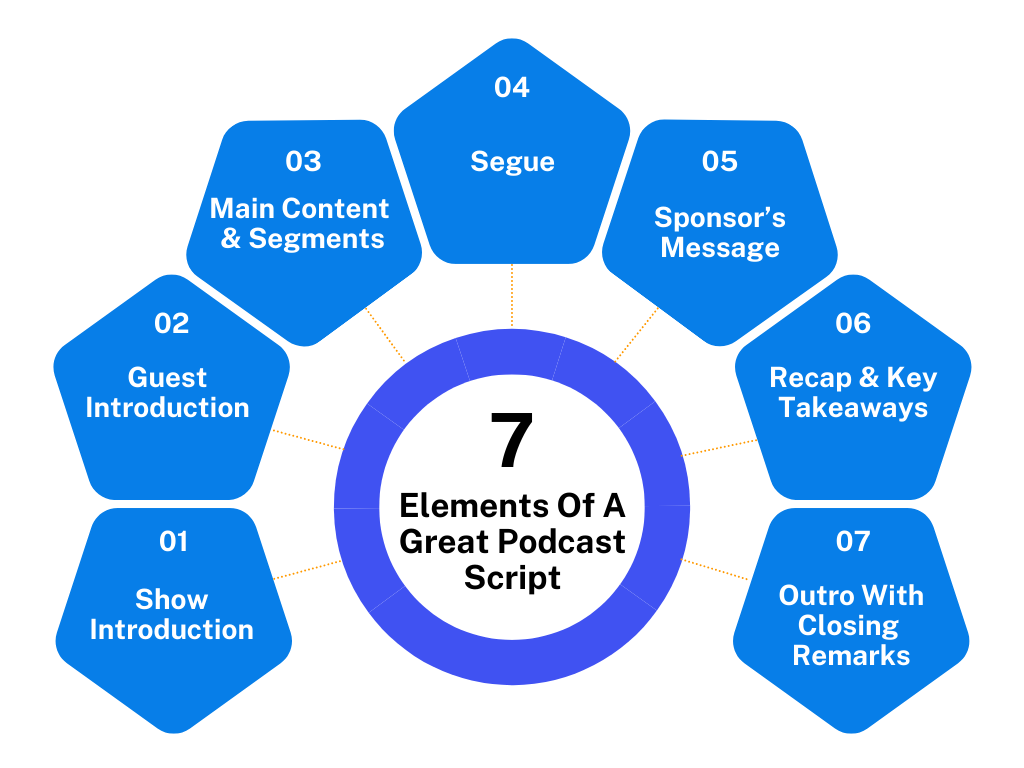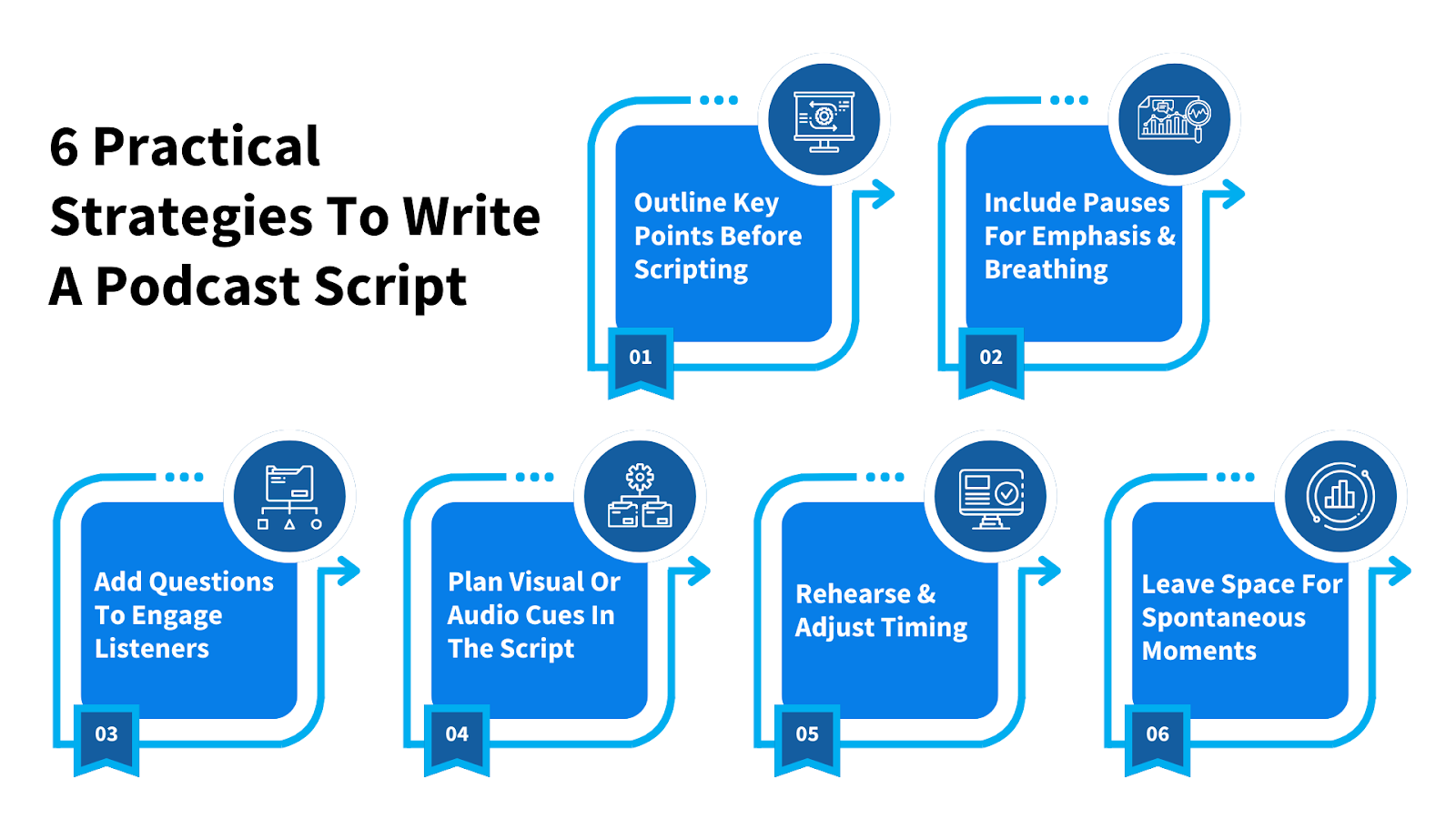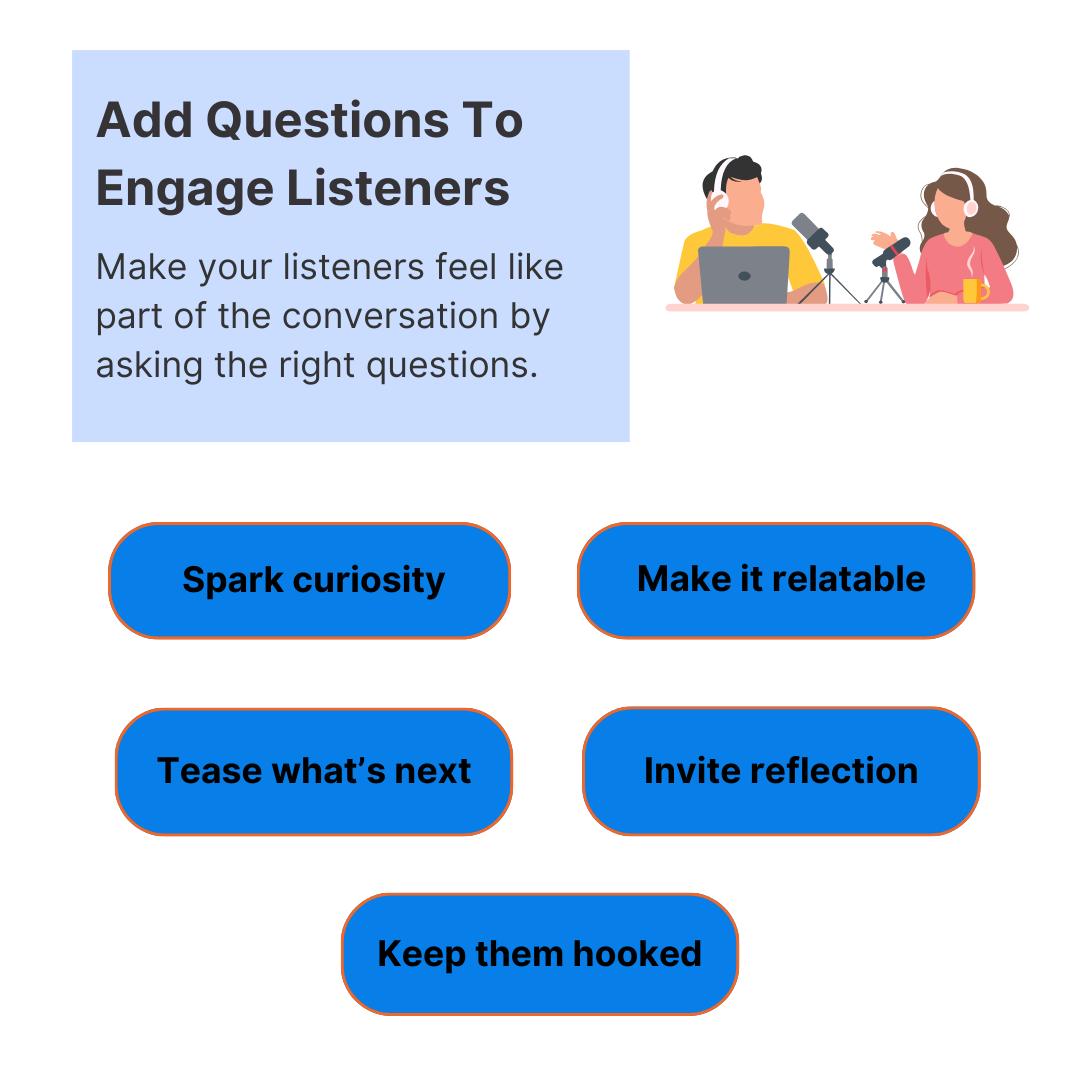
How to build a profitable podcast.
Learn a simple podcast script template to keep episodes engaging and your listeners coming back.

Podcasting is brutal. You are brimming with ideas, and then your brain throws a tantrum. Words vanish. Thoughts collide. You try to be funny and interesting, but somewhere around the third sentence, it all falls apart. That is where a podcast script template saves you from flopping while still letting your personality run wild.
Here, we have 5 ready-to-use podcast script templates that pull people in from the first line and don’t let go. Plus, we will show you how to create your own script, so every episode has rhythm and feels 100% like you.

The right podcast structure gives your show flow and makes it easier for listeners to follow along. Let’s break down the 7 key elements that make up a perfect podcast script.
The podcast intro is your first impression. It is that moment where your listener decides, “Yes, I want to stick around.” A great intro quickly tells your audience what the podcast is about and why it matters to them. Some podcasts make it a few lines, others add music or sound effects to make it instantly recognizable.
In guest interviews, how you introduce the person matters a lot. And this goes beyond stating their name and title – you have to give listeners context for why this person is relevant to the podcast episode. If you are running the show with a co-host, make sure both of you get a quick moment to connect with the guest.
The tone here can shift depending on your podcast’s style – some podcast hosts go professional and polished, others keep it casual and conversational. But the structure stays the same: establish credibility and transition into the discussion.
This is the heart of the podcast – the part where listeners get the real value. Every show handles this differently. Some have one continuous conversation, while others break it into segments or recurring themes.
For example, you might have a Q&A section or a storytelling block. No matter the style, this is what people showed up for. It is where the depth and substance sit.
Segues are the small bridges between different parts of your podcast. They tell listeners that you are moving from one topic or segment to another. These transitions are tiny, but they are powerful.
Segues are what keep your show from feeling choppy. It might be a quick line that ties two topics together or even a short sound cue. Done right, it feels natural, like a smooth turn in a natural conversation instead of a hard stop.
If your show has sponsors, this is where you slot them in. It is usually short and meant to be a part of the episode without being jarring. The sponsor’s message comes in the form of a mid-roll or pre-roll ad, depending on placement.
The best sponsor messages keep the same conversational tone as the rest of the show, so listeners don’t feel like they have suddenly been hit with an ad break.
This element brings everything back together before the episode winds down. You basically summarize the main points and give them the “carry-home” version of the show – something they can remember and talk about. It is short, but it leaves a strong final impression of what the episode was all about.
The outro is your final moment with the listener. It is where you bring everything to a close – thank your guest if someone joined, or give your audience a quick shoutout. You can even hint at what is around the corner.
A lot of podcasts like to finish it off with music or credits, just to make it feel complete. The whole point is to wrap things up in a satisfying way and give people a reason to come back.
To save you the hassle of starting from scratch, here are 5 different podcast formats you can run with – just pick the one that feels right for your style.
Intro Music + Host Greeting
“Welcome to [Podcast Name], the show where we [quickly describe what the podcast does]. I’m your host, [name], and today we’ve got an exciting conversation lined up.”
Guest Intro
“Joining me is [guest name], [their role/achievement]. They’ve done [highlight 1–2 relevant points], and we’ll be talking about [main topic].”
Warm-up Question
“Before we dive in, I’d love to start with [light question].”
Main Interview Script Flow
Transition To Wrap-up
“Before we close, I want to ask…”
Closing Question
“What’s one piece of advice or insight you’d like to leave our listeners with?”
Outro
“[Guest name], thank you so much for joining. And to everyone listening, make sure to [call to action like subscribe/share]. See you in the upcoming episodes!”
Intro Music + Greeting
“Hey everyone, welcome back to [Podcast Name]. I’m [your name], and today we’re digging into [topic].”
Quick Context
“Here’s why this matters… [set up the problem or opportunity].”
Main Content Broken Into Sections
Mini Recap
“So far we’ve covered [list key points].”
Personal Touch
“Here’s how I personally apply this, and why I think it can help you.”
Outro
“Thanks for hanging out with me today. If you found this helpful, don’t forget to [call to action]. I’ll catch you in the next one.”
Intro Music + Greeting
“Welcome to [Podcast Name]. I’m [your name], and today’s episode is a panel discussion on [topic]. With me are [list panelists’ names + quick titles].”
Set Expectations
“We’re going to cover [main theme] and break it into [number of segments].”
Opening Question For All Panelists
“To kick things off, I’d love for each of you to share [simple, unifying question].”
Segment 1
Segment 2
Segment 3 – Optional
Audience Q&A, if it’s live, or prepared listener questions.
Final Thoughts Round
“Before we wrap, I’d love one short takeaway from each of you.”
Outro
“Big thanks to our panelists [names]. And thanks to you for tuning in – see you in the next episode!”
Intro Music + Mood Setting
“From [Podcast Name], this is [Episode Title]. I’m [your name]. Today’s story begins [set the scene in 1–2 vivid sentences].”
Act 1 – Setup
Introduce characters, background, and stakes. Use short, descriptive lines:
“[Character] was [situation]. They didn’t know it yet, but [foreshadow key tension].”
Act 2 – Rising Action
Describe events in sequence. Mix narration with clips, quotes, or sound design cues.
“[Narration]. [Clip/quote]. [Narration continues].”
Act 3 – Climax
“This is where everything changed… [describe the turning point].”
Act 4 – Resolution
Wrap up the outcome and lessons learned. Tie it back to the opening.
Outro Music + Closing
“You’ve been listening to [Podcast Name]. This episode was produced by [names]. If you enjoyed it, please [call to action].”
Intro Music + Greeting
“Welcome to [Podcast Name], where we make [topic] simple. I’m [your name], and today we’re covering [lesson/skill].”
Set Learning Outcome
“By the end of this episode, you’ll know how to [clear goal].”
Step-by-Step Breakdown
(Add short stories, comparisons, or quick data where helpful)
Mini Recap
“Let’s go over the steps again quickly: [list them].”
Extra Tip Or Bonus Insight
“Here’s one more thing that can make the process easier…”
Outro Music + Closing
“That’s it for today’s episode. If you learned something new, share it with a friend or leave a review. Until next time, I’m [name], and this was [Podcast Name].”

Instead of stuffing your podcast episode script with filler or overthinking every line, let’s break down 6 ridiculously simple steps to keep your audience glued to their headphones.
If you jump straight into writing a word-for-word script, you will either ramble or lose your flow halfway through. The smarter move is to jot down the podcast outline with key points first.
Here’s what to do:
Now, when you script it out, you are just fleshing out the bones instead of starting from scratch.
That said, you don’t always have to start with a blank page, either. A lot of podcasters use ready-made resources like blog posts and guides when they are sketching out their outline. This gives a solid structure right away and keeps you from missing important angles.
Here’s an example worth sharing. Let’s say you are in the lifestyle niche and you are making a podcast about setting up an outdoor kitchen. This detailed guide on outdoor kitchens can moonlight as your prep tool.
You could grab their step-by-step breakdown of choosing the right layout and picking weather-resistant materials, and then map those points into your episode outline. From there, you add your own voice – stories, tips, or even mistakes you have seen people make. Suddenly, you have a script that is both structured and personal.
Most podcasters forget this and sound like they are in a race. That is when listeners tune out. A pause gives your words weight and gives you air.
Here’s what helps:
Silence isn’t dead air. Silence is part of the performance. Listeners need time to digest, and you need time to breathe.
Now, how much you pause really depends on who you are talking to. If your audience is mostly Gen Z, you can afford to keep the pace quick and the pauses short. They grew up on TikTok and YouTube shorts, so their ears are trained for quick delivery. In fact, if you slow down too much, they will feel like you are dragging it out.
But switch the audience, and the rules change completely. If you are creating a podcast for seniors to help them choose the right medical alert device, the last thing you want to do is speed through the details.
Older listeners process information more slowly, and they need time between points to really absorb what you are saying. If you cram features, pricing, and setup steps into one long breathless rant, you will lose them before they can even follow along.
When you are recording, the last thing you want is to be fumbling around thinking, “Wait, where was I supposed to add that sound effect?” That is how things get messy. Instead, treat your script like a detailed outline for a live show.
What this looks like in practice:
Plenty of podcasters push this even further. For example, some have custom dashboards that trigger sound effects with one click, while others use automation to drop music beds and visuals at the exact time stamp they want. Bigger shows even sync podcast episodes with livestreams, where audio cues and video transitions run automatically.
If you want your show to run on that level of polish, you can partner with a software developer to build tools that fit the way you record. It might be as simple as a plugin that handles cues for you, or as advanced as a custom app that manages sound, video, and effects in real time.

You can’t see your podcast community, but they should feel like you are talking right to them. Questions pull them in. They stop scrolling and start nodding along in their car or wherever they are.
Try mixing in these types of questions:
Notice the trick? Each question is a little hook that pulls your audience forward. Instead of zoning out, they lean in and wait for what comes next.
Reading your own script silently isn’t enough. Podcasts live and die on how they sound, and you only catch pacing issues once you read them out loud. This is where rehearsal saves you.
Here’s a routine that works:
A script helps you stay on track, but if you stick to it line by line, it comes off stiff. The best bits are those off-the-cuff moments – the random story you drop in or the side note you didn’t plan. That is what makes people feel like they are right there with you.
How to build that into your own template:
Bonus Next Step: Get Your Podcast Found
Getting your podcast script template right is half the battle. You can pour your soul into episodes, but if no one finds them, all that effort sits in the dark. Step two is making sure people can actually discover it. And for that, you need to have strong SEO and smart promotion.
A simple starting point is to turn your script into a blog post or detailed show notes so that anyone Googling for your topic can find your podcast. You can also add real search terms to give search engines a reason to put you in front of new listeners.
And if you are ready to really grow, hiring an SEO agency that knows podcasting can put your show in front of the right ears faster than you could on your own. They will research exactly what your audience is searching for and even build backlinks from relevant sites to push your podcast higher in rankings.
Some agencies also help map out content clusters – meaning your podcast episodes, blog posts, and supporting pages all link together to signal authority to Google. In plain English: you are no longer relying on word of mouth or social shares; people actively searching for answers can find you.
That is the real unlock. Your script keeps listeners hooked once they are in, but SEO is what brings them through the door in the first place.

Most podcasters trip over the same handful of mistakes without even realizing it. Let’s call them out, one by one, and we will show you exactly how to avoid them so your episodes stay sharp and worth every listen.
Nothing makes a podcast more lifeless than someone glued to a script. You can literally hear the reading voice. The problem is that listeners came for a conversation, not an audiobook.
How To Avoid It:
Then some podcasters think they can freestyle it, and the show will somehow work itself out. Spoiler: it rarely does. You end up circling the same point or losing your train of thought completely.
How To Avoid It:

Listeners are busy. They have 50 other podcasts waiting in their queue. If you drift or bury the lead, they are gone. The script has to respect that.
How To Avoid It:
Now, this gets even more important if your podcast covers complex topics. Let’s say you run a finance or real estate podcast. You might be explaining something technical, like cost segregation. That subject is packed with tax rules and property categories that could easily overwhelm anyone listening.
Here’s the smart move: look at how this California cost segregation resource is written. Notice how it breaks everything into sections and lays out the process step by step instead of dumping it all in one chunk. That is exactly what you want your script to do.
So instead of throwing every single detail at your listeners in one long rant, pace it. Lead with the “why it matters,” then move into the main points one by one. Add real-world examples or case studies so it doesn’t just fly past them. And always pause after the heavier stuff so people have time to process before you hit them with the next fact.
That is how you respect attention spans. You are still giving listeners the depth they came for, but you are packaging it in a way that doesn’t push them to zone out or switch shows.
Calls-to-action (CTAs) aren’t the problem. Where you stick them is. Drop them too early and you sound pushy. Leave them for the very end, and most people have already tuned out.
How To Avoid It:
You may have great points, but if you jump between them with no bridge, listeners feel jerked around. Smooth transitions are the difference between a conversation and a checklist.
How To Avoid It:
The people who win in podcasting are the ones who balance structure with personality. Too loose, and you ramble. Too rigid, and you bore. A good podcast script template sits right in the middle, keeping the backbone strong while your personality still runs the show.
If you are thinking about next steps, we at bCast are right there with you. Our blog is weekly ammo packed with how-tos, ideas, and inspiration so your show thrives. With stacks of actionable, real-world insight, we will help you turn 5 listeners into 500… and beyond.


Where you learn how to start and grow a profitable podcast.